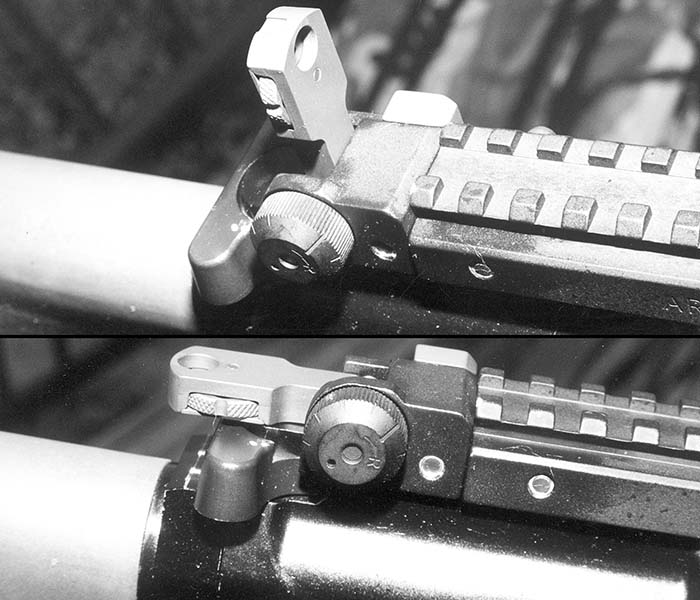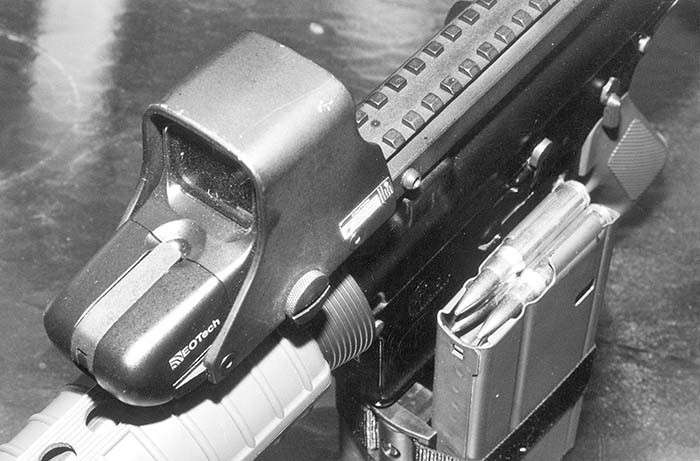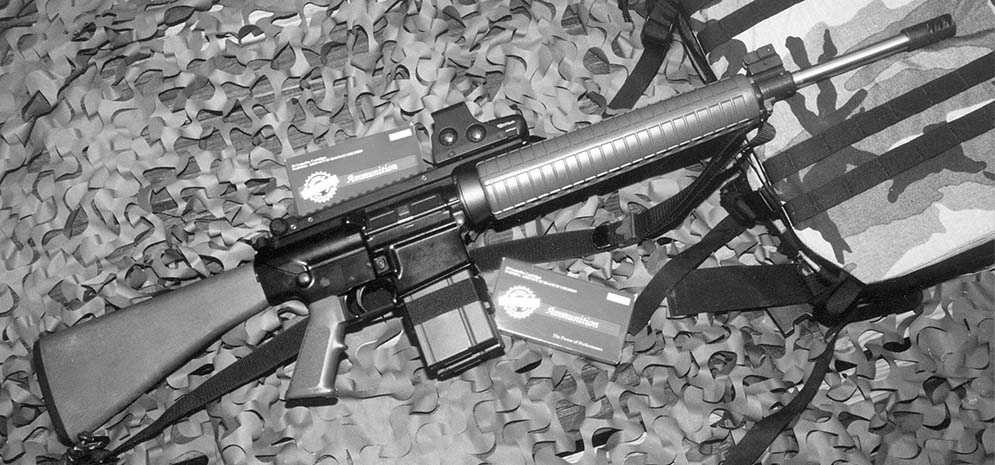By Charles Q. Cutshaw
According to Mark Westrom, CEO of Armalite, the company’s AR-10A4 is the most popular model of the resurrected and modernized 7.62x51mm (.308 Winchester) rifle, predecessor of the ubiquitous AR-15. Certainly the AR-10A4 offers great versatility, with flat top receiver and gas block coupled with a lower price than Armalite’s AR-10(T) precision rifle. Although not a match rifle, the AR-10A4 offers good accuracy and reliability in a field grade rifle. Our personal AR-10A4 is one of the early versions of the rifle and it has given faithful service for many years. The big AR, however, almost begs to be adapted as a semiautomatic “scout” rifle following the concept originated by Jeff Cooper. The AR-10A4 is relatively lightweight and compact, especially in its carbine configuration. The handiness of the carbine version, however, is offset to a degree by increased felt recoil and a palpable muzzle blast.

Our AR-10A4 has always delivered approximately minute of angle accuracy, so our focus will be on the conversion into scout rifle configuration. The notion of AR-10A4 as scout rifle did not originate with this author. Indeed, Tom Newhall of GG&G proposed the idea some time ago and it was manifested in his AR-10 F.I.R.E System modification of the rail mounting system already in use by some units of the U.S. Marine Corps on their M-4 carbines. The F.I.R.E. acronym stands for “Fully Integrated Rifle Enhancement System” and consists of several components that enhance the utility of the AR-10A4 as a scout rifle. These include a scout length rail that projects approximately three inches forward of the receiver to allow mounting a long-relief optical sight, GG&G’s MAD (Multiple Aperture Device) backup rear sight, and flip up front sight. These components enable the owner to convert his AR-10A4 into a true scout rifle configuration.
The GG&G F.I.R.E. rail mount is a MIL-STD-1913 design made of aircraft grade aluminum. The rail that we installed is the standard mount for shooting out to 500 meters, or for the long-range shooter, a rail with 15 minutes of angle built in is available. The GG&G rail is hard anodized in gray that exactly matched the finish of our AR-10A4. Attaching the rail to the receiver of the AR-10A4 was as simple as placing it properly so as to mount the backup M.A.D. iron sight and obtain the proper relationship of the cantilevered scout mount with the rifle’s receiver. The rail is retained with hex-head screws that are threaded into stainless steel inserts so as to avoid stripping threads in the aluminum. The necessary wrench for installation is included with the rail kit. To ensure that the rail stays in place, we used “Gun Tite” on the threads. This is a low strength Lock Tight that ensures that screws do not loosen, but can be easily broken loose with a screwdriver or wrench without damage.
The MAD backup rear sight fits flush with the rail mount at the rear of the receiver and the sight itself folds flush with the rail’s top surface so that it does not interfere with the scout optics. This unit’s mounting block is of aircraft grade aluminum with stainless thread inserts, while the sight and aperture disc are of steel. The sight is also hard anodized with steel components phosphated. The steel components are a slightly lighter gray than the AR-10’s receiver. The MAD’s apertures are dimensionally identical to those of the M16A2, but unlike the M16’s, which flip back and forth between two apertures, the MAD has four alternating large and small apertures in a rotating disc that we found more convenient than the usual system. The edges of the disc are knurled for positive grip. The MAD sight is adjustable for windage, but not for elevation, which must be accomplished using the front sight. This was the original AR system and is acceptable in a backup sight, and although elevation adjustments can be accomplished using a bullet tip, the task is easier using a specialized tool.

The folding front sight simply clamps onto the gas block. Unlike the rear sight and rail, the front sight is of all steel construction. The front sight guard is serrated on its outer surface to provide a gripping surface. Having the front sight folded out of the way is a decided advantage when using optical sights because it does not interfere with the shooter’s line of vision, yet is instantly available when required. The optical sight is probably the most critical element of a scout rifle system. Typically, scout rifles use optics ranging from 1x to 2.5x. This is to ensure the speed of target acquisition and accuracy inherent in the scout concept. While any number of sights would have sufficed for our purposes, we installed one of EO Tech’s 1x second generation HoloSights on our AR-10A4. The HoloSight is one of the premier electronic optics available today. It is actually a hologram projected by a laser onto a piece of hardened glass. The HoloSight incorporates a 1 MOA center red dot surrounded by a 65 MOA circle. When used properly, i.e. with both eyes open and looking at the target, the 65 MOA circle automatically brings the center red dot onto the target as the rifle is brought up to a firing position. Unlike other red dots, that of the HoloSight does not obscure the target, nor does it seem to grow larger as intensity is increased to compensate for bright sunlight. The latest military and law enforcement versions of the HoloSight have ten levels of night vision built in, as compared to only two levels in competitive units. The current HoloSight is waterproof to only ten feet, but since we do not plan on using our rifle for deep-water swimmer deliveries, that is more than adequate. We understand that new versions of the HoloSight, to be introduced in the near future will be waterproof to 33 feet.

The final element of our FIRE’d AR-10A4 was one of Buffer Technologies’ Mag-Cinch dual magazine mounting systems. The Mag-Cinch is the only such system that locks a rifle’s magazines together in a virtually inseparable bond that gives, in the case of the AR-10, 40 rounds of instantly accessible ammunition “on the gun.” In everyday use, the added weight of a second magazine of 20 rounds of 7.62mm cartridges ready for instant insertion into the rifle’s magazine well is almost certainly overkill and probably unnecessary. On the other hand, having such “overkill” available just as certainly drives the likes of “Barbara Fineslime,” the “Violence Propaganda Center” and their ilk to distraction. For that reason alone, it is worth doing!

While the AR-10A4 is a fine rifle in its standard configuration, the enhanced scout configuration that GG&G’s F.I.R.E. system affords makes a good rifle even better. The components are manufactured to a high quality standard and fit the rifle perfectly. The added eye relief that GG&G’s F.I.R.E. system adds to the AR-10’s rail is ideal for a low power, long eye relief telescopic sight, or for a 1x optic such as the HoloSight. It is an accessory that we find particularly useful and we recommend it to those who wish to enhance the versatility of their AR-10A4 or AR-10(T) rifles.
Armalite
PO Box 299
Geneseo, IL 61254
Tel: 309-944-6939
Fax: 309-944-6949
www.armalite.com
email: info@armalite.com
Buffer Technologies
(Mag-Cinch)
PO Box 104903
Jefferson City, MO 65110
Tel: 573-634-8529
Fax: 573-634-8522
www.buffertech.com
EOTech, Inc.
3600 Green Court, Suite 400
Ann Arbor, MI 48105
Tel: 734-741-8868
Fax: 734-741-8221
www.eotech-inc.com
GG&G
3602 E. 42 Stravenue
Tucson, AZ 85763
Tel: 520-748-7167
Fax: 520—748-7583
www.GGGAZ.com
email: GGGAZ@aol.com
| This article first appeared in Small Arms Review V5N5 (February 2002) |











